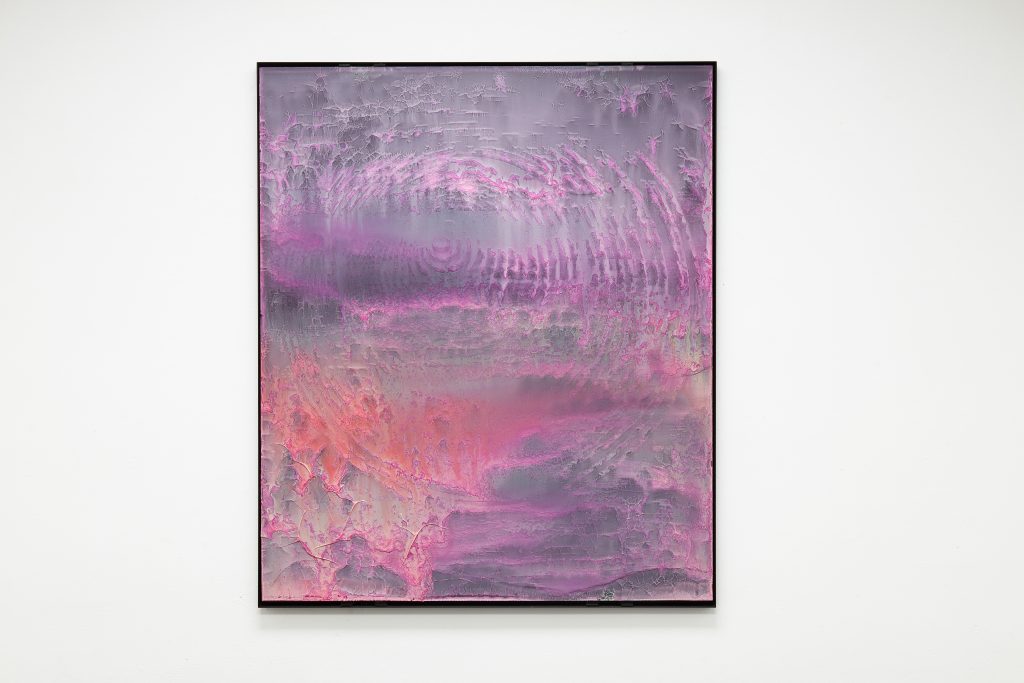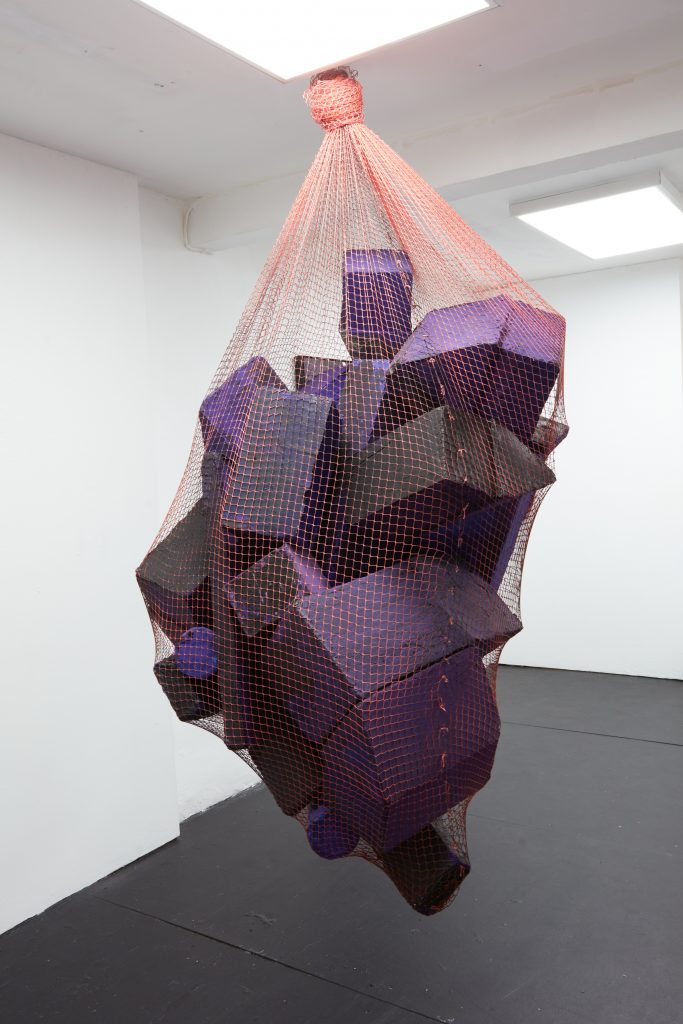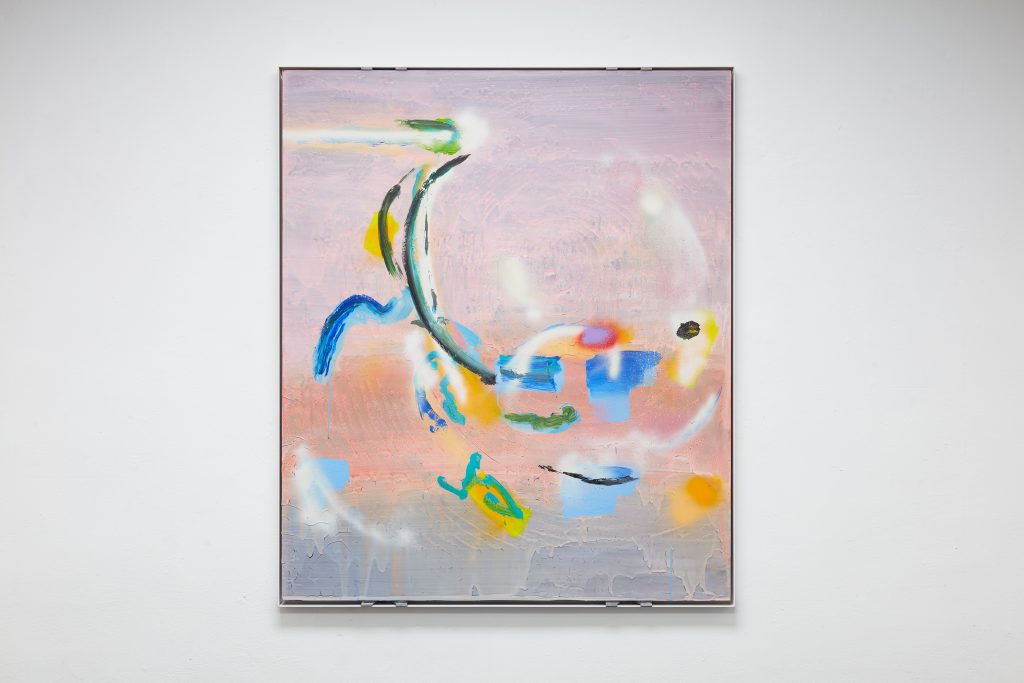DAEMON
WAVES

Q: Tell us more on your current show―I’m curious about the title.
A: It was just this kind of acknowledgement of the stuff we all know―the warping forces of media/social media coupled with the climate crisis creating this apocalyptic situation that we have always been promised we would get in films growing up, and because of the total ideological domination of neoliberal politics, no real counter force being allowed to be taken seriously. So yeah we live in the brain of a daemon eating its children, we live in a trashy 90s sci-fi film like Total Recall. It’s kind of darkly funny how those tech nutters that get to run the system because they accumulated the most capital openly admit they are influenced by those films, so I was exploring that aesthetic too.
Q: Your work incorporates salvaged and readymade objects―are they the initial inspiration for a piece?
A: Yes, with this series I am working with salvaged solar panels. Sometimes they are installed as walls, forming a structure you walk through, but in this show I present them as paintings. I like the idea of covering them with a skin of paint so you end up with an object that has technology embedded in it like many manufactured objects. The solar panel is directly relational to light like an eye or a mirror―it’s a kind of technology that is perhaps only just beyond our intuitive understanding, so it feels already loaded with meaning that you can inflect with a painting language in a different way than working on a canvas with those very different histories.
Q: In terms of an aesthetic, are there particular ways you work that help you arrive at a certain visual coherence?
A: I work with material relationships, like how paint slides across glass. I find glass interesting as it is a more hostile surface than something like linen, and so somehow more contemporary, and it directly relates to the idea that the picture might be a window opening onto a world or a screen. I make a template and etch some kind of simple format onto the panel, like moons or a black hole and then choose a colour palette and start adding thin washes. The way the paint aggregates around the etched areas creates a kind of indication for a way forward. The piece might be complete after a few layers and read as kind of landscape or I might add additional layers and have more foreground information.
Q: How does surface and materiality relate to meaning in your work?
A: There are various interpenetrating surfaces in every object, for example in the wall pieces, how the steel wraps around the glass panel and creates a shadow gap―this gives the piece sculptural depth that can be related to in a bodily way. With the hanging object, the net surface is warped by the model buildings it contains, and the outside and inside become indeterminate, a kind of body horror but applied to an architectural model. This piece is called ‘the only game in town,’and relates to how we might find ourselves sympathising with certain ideological distortions to get by.

Q: I often think of the surface of Solaris when looking at abstract work―does this idea resonate with you?
A: For a while for me that film was a kind of shorthand for thinking about the potentiality for art in the world. How the crew of a ship visit a kind of consciousness that is also a planet that they can explore, this planet then somehow studies the crew and builds simulacra people that look like their dead lovers to torment them. The scene where the camera glides across the surfaces of Bruegel paintings installed on the ship in the same way Solaris presumably glides through the crew’s dreams, and how these perspectives relate to Bruegel’s 16th century picturing device of a gods eye view of landscapes is so wonderfully playful and disturbing, and how this is then compounded by the ship loosing gravity and the crew floating for a moment. I found it an interesting way to think about the artist/art object/audience relationships. Also of course how the surface of Solaris is a mist that congeals into objects. And all of this prefaced by the long shot of the car moving through the highways of Moscow so full of foreboding energy.
Q: How does your work connect with the infinite?
I don’t know, but it makes me think about how time felt different when I lived in squats for a decade. You would cut open a door with an angle grinder and set up a kind of space that was slightly detached from the world of working to survive. You had this incredible luxury of time and space and you could get a lot of real work done.
Q: When do you know a work is completed? Does something ‘happen’?
It’s completed when it feels compelling on its own terms. What happens? I don’t know, hopefully that humble thing where you see elements of the world reorganised in the work and it encourages you to imagine things being reorganised in the world. I love the feeling when you leave a show and it feels like there is somehow more possibility in the air.

Daniel Pasteiner studied sculpture at the Royal College of Art. He lives and works in London.
To see more of Daniel’s work: @danielpasteiner
The exhibition Daemon Waves runs until the 27th of November at studio1.1. @studio1.1_london, www.studio1-1.co.uk
Photo Tom Carter @tomcarterldn